The Genetics of Coloration in Texas Longhorns: Part 2: Grulla, Dun, and Other Reduced Pigment Patterns
© David M. Hillis, Double Helix Ranch
Section of Integrative Biology, University of Texas, Austin, TX 78712
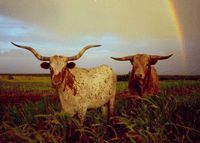
Texas Longhorns at the
Double Helix Ranch
This article is the second of a five-part series on the genetics of coloration in Texas Longhorn cattle. This article was published in Texas Longhorn Trails, Volume 16, number 5, pages 76-77 (2004). If you have comments or questions about this article, please e-mail me.
This article is intended for a general audience of Texas Longhorn breeders, rather than a technical audience. However, some scientific jargon is unavoidable, so if any of the terms are unfamiliar, please see the Glossary.
In part 1 of this series,
I discussed variation at the Extension gene, which produces the
three basic colors of Texas Longhorns: black, red, and wild-type. As a
reminder, these three colors are produced from three versions (alleles)
of the Extension gene. These different versions of the gene control
the production of the only two pigments that are present in Texas Longhorns,
eumelanin (a black pigment) and phaeomelanin (a red pigment). The version
of the gene that was present in wild aurochs (called the wild-type allele,
and abbreviated E+) is still present in Texas Longhorns today.
This wild-type allele permits the production of both eumelanin and phaeomelanin
(by controlling the production of an enzyme called tyrosinase), and the
varying concentrations of these two pigments produce colors such as Parker
brown and brindle. Two other alleles of the Extension gene that
occur in Texas Longhorns are simple mutations from the wild-type allele.
One allele produces black coloration in any pigmented hairs, because it
results in the over-production of eumelanin. The black allele is abbreviated
ED, and it is dominant over the other
alleles. This means that an animal with a single copy of the black allele
(from just one of its parents) will be black. The other allele that is
present in Texas Longhorns results in production of phaeomelanin only,
and so the animal is red. This allele is abbreviated e, the lower-case
letter indicating that it is recessive to the other two alleles. Thus,
an animal will only be true red if it has two copies of the red allele
(one from each parent).
All Texas Longhorns have one of these three basic colors, but obviously
there are many more than three simple colors and patterns of Texas Longhorns.
This is because there are many other genes that influence cattle coloration,
and produce complex patterns of white (unpigmented) hairs, spotting patterns,
and reductions in pigmentation. This month, I’ll discuss the genes
that result in a reduction in pigmentation, to produce colors such as
orange, yellow, grulla, and dun. In future columns, I’ll discuss
the various interesting patterns produced by the wild-type coloration,
as well as patterns that include areas of white (which results from a
lack of either of the two pigments).
There are at least two genes that can reduce the total amount of pigment
produced in a given hair. One of these genes is known as the Dilution
gene. The common (wild-type) allele of this gene in Texas Longhorns (ds+)
produces no change in the coloration (so a black cow will appear black,
if it is also homozygous ds+/ ds+).
However, if a cow inherits one copy of an incompletely dominant dilution
allele (Ds), then a black cow will appear
dark gray (dark grulla; Figure 1), a wild-type cow will show various shades
of light red and grey (medium grulla; Figure 2), and a red cow will appear
light red, orange, or golden (Figure 3). If both copies of the gene are
dilution alleles (i.e., the animal is homozygous Ds/Ds),
then the black cow will appear light gray (light grulla; Figure 4), the
wild-type cow will be a light reddish grey, and the red cow will appear
yellow or light golden (Figure 5).
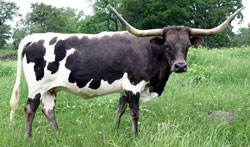
Figure 1. Dark grulla cow
(Phenomenal Orchid).
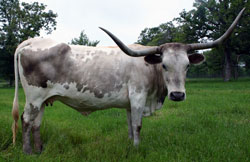
Figure 2. Medium grulla cow (Miracle).
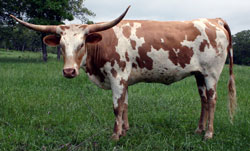
Figure 3. Light red cow
(Star Just Go Britely)
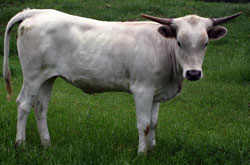
Figure 4. Light grulla heifer
(Star Gathering Light).
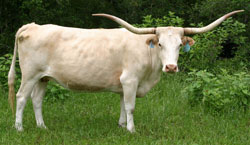
Figure 5. A light golden cow
(Yellow Mystique).
However, to make things more complicated, all light-colored
animals do not result from the Dilution gene. Allelic variation
at another gene (called Dun) can also produce the dun coloration.
The allele dn is incompletely recessive to the wild-type allele
for this gene (Dn+). Individuals that are heterozygous Dn+/dn
have a reduced amount of red pigment (phaeomelanin), but there is little
effect on black pigment (eumelanin). If a cow or bull has the black (ED)
allele for the Extension gene and is also heterozygous (Dn+/dn) for the
Dun gene, then it will likely have some dark reddish brown (rather than
black) along the back and on the poll. The effect on red is more uniform,
and homozygous red (e/e) animals that are also heterozygous at
the Dun gene (Dn+/dn) will be duns (the color is even
lighter in homozygous dn/dn animals).
Animals that are homozygous dn/dn show a more uniform reduction
in pigmentation, for both black and red pigmentation. Thus, an animal
that would normally be black, but is also homozygous dn/dn for
the Dun gene, would appear grulla, and would be difficult to
distinguish (without additional information on its ancestors or offspring)
from an animal that is grulla due to the presence of the Dilution
allele. Likewise, an individual that is homozygous dn/dn for
the Dun gene and also homozygous e/e for the Extension
gene would look very light red or even yellow.
How can you use this information? Suppose that you would like to breed
all grulla catlle. How can you select a bull and cows that would always
produce grulla cattle? If you simply pick any grulla cow and any grulla
bull, then you might be disappointed in the results. Imagine, for instance,
if we selected a bull that was heterozygous ED/e
for the Extension gene, homozygous dn/dn for the Dun
gene, and homozygous ds+/ ds+
for the Dilution gene. Suppose the cow we have selected, however,
is heterozygous ED/e for the Extension
gene, homozygous Dn+/ Dn+ for the Dun gene, and heterozygous
Ds /ds+ for the
Dilution gene. Both of these animals would indeed be grullas,
but only 3/8ths of the offspring would be grulla (another 3/8ths would
be black, 1/8th would be light orange or yellow, and 1/8th would be light
red).To see how these numbers are calculated, consider the table below.
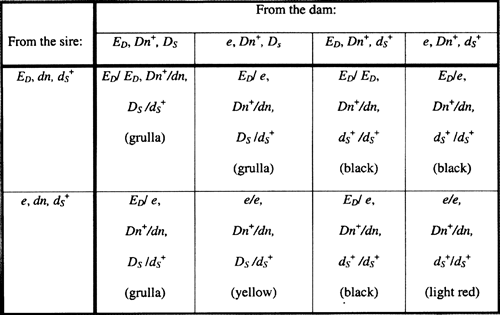
The table shows the possible genotypes of eggs produced
from the dam, and of sperm produced by the bull, assuming that all three
genes are independent of one another (i.e., on separate chromosomes).
The cow can produce eggs of four different genotypes (genetic combinations),
because she is heterozygous for two of the genes. The bull, on the other
hand, can only produce sperm of two genotypes (at least if we only consider
the three genes under discussion here). The four genotypes produced by
the dam are arranged across the top of the table, and the two genotypes
produced by the sire are arranged in the first column of the table. The
genetic combinations that are expected in the offspring occupy all the
rest of the cells of the table, and are simply the combinations of each
of the possible genotypes of sperm and egg. Thus, of the eight genetic
combinations that are predicted for the offspring of this cow and bull,
we can see that three of them will be grulla, three will be black, one
light orange to yellow, and one light red. The light orange to yellow
offspring results because of the basic red coloration (e/e at
the Extension gene), together with the combined effects of the
Dilution and Dun genes. The light red individual, on
the other hand, has the same basic red coloration, as modified by the
heterozygous Dun locus.
In contrast to the example just discussed, however, consider what happens
with a bull that is homozygous black for the Extension gene (ED/
ED) and also homozygous for the dilution allele
(Ds/ Ds). This
bull would be a light grulla, and would produce all grulla offspring when
mated to ANY cow. By this I mean that any colored areas of the calves
would be grulla; they could still have large areas that were unpigmented,
depending on the white-spotting genes that were present. Even if the cow
was red and had no pigment-reducing alleles, its offspring by this mating
would still inherit at least one ED allele
and one Ds allele
from the bull. Since these are both dominant alleles, then the offspring
would all be black and diluted (which results in grulla coloration). Note,
however, that the grulla coloration would be darker than that seen in
the bull, unless the dam also carries a dilution allele (Ds)
and passes this on to the offspring as well. A simple genetic test is
available commercially to determine the genetic makeup at the Extension
gene (the cost is about $40 per animal). There is not yet a commercial
test for the Dilution gene, although progress in the cattle genome
project should make a test practical before long.So, if you really like
grulla coloration, you can have all grulla calves by selecting the right
bull. You don’t need to buy a bunch of grulla cows to succeed (although
that will help if you don’t have the perfect bull). On the other
hand, if you enjoy the elements of surprise and diversity, then using
the heterozygous bull discussed in the first example will produce that
result.
The Dilution and Dun genes can have some especially
interesting results when they occur together with the wild-type coloration.
Often, animals with this combination of genes will appear light red at
birth, but will turn a smoky red (or some combination of red and grey)
as they age (Figures 6 and 7). This is because the hairs that would normally
turn black as the animal ages (as would be typical for wild-type coloration)
instead turn grey, and the hairs that would normally be red turn light
red or yellow. Figures 6 and 7 show just a few examples of the interesting
color patterns that are produced from wild-type coloration in combination
with the Dilution gene. Other interesting colors that result
from wild-type coloration (without any dilution) will be the subject of
next month’s article in this series. These other wild-type patterns
include such striking colorations as brindle, Parker brown, walnut, and
wine-colored.
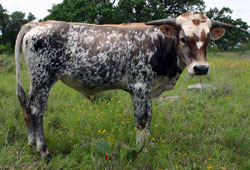
Figure 6. A wild-type colored calf that
is heterozygous for the Dilution gene (Ds/ds+).
The wild-type coloration produces many
combinations of grey and light red coloration
in combination with the Dilution gene.
The white spotting is the result of another gene
(the subject of a future installment in this series).
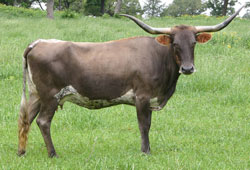
Figure 7. Another example of wild-type coloration
in combination with the Dilution gene.
Without the effect of the Dilution gene,
this cow (Double L Tammy) would be Parker Brown.
Acknowledgements: I thank Darlene Aldridge and John Parmley for allowing me to photograph their cattle for this article, as well as for discussions of her experiences with breeding grulla cattle. Darlene and John own all the cattle illustrated in this article except for the calf shown in Figure 6.
Want more detail? Please see the following papers:
Additional Reading and References
Joerg, H. et al. 1996. Red coat color in Holstein cattle is associated with a deletion in the MSHR gene. Mammalian Genome 7: 317-318.
Klungland, H. et al. 1995. The role of melanocyte-stimulating hormone (MSH) receptor in bovine coat color determination. Mammalian Genome 6: 636-639.
Lauvergne, J. J. 1966. Génétique de la couleur de pelage dex boivins domestiques. Bibliographia Genetica 20:1-168.
Olson, T. A. 1980. Choice of a wild-type standard in color genetics of domestic cattle. Journal of Heredity 71:442-444.
Olson, T. A. 1981. The genetic basis for piebald patterns in cattle. Journal of Heredity 72:113-116.
Olson, T. A. 1999. Genetics of Colour Variation. In The Genetics of Cattle (R. Fries and A. Ruvinsky, eds.). Pp. 33-53. CABI Publishing, Wallingford, United Kingdom.
Robbins, L. S. et al. 1993. Pigmentation phenotypes of variant extension locus alleles result from point mutations that alter MSH receptor function. Cell 72:827-834.